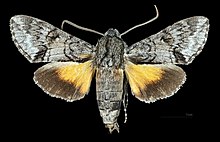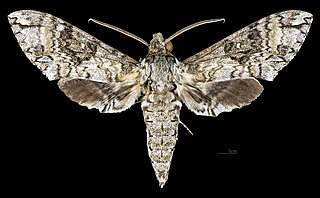
Manduca brontes is a species of moth in the family Sphingidae first described by Dru Drury in 1773. It is known from Jamaica, Cuba, Haiti, Puerto Rico, the Cayman Islands, the Dominican Republic and Suriname.

Cocytius antaeus, the giant sphinx, is a moth of the family Sphingidae. The species was first described by Dru Drury in 1773.

Manduca occulta, the occult sphinx, is a moth of the family Sphingidae.

Sphinx asellus, the asellus sphinx moth, is a moth of the family Sphingidae. The species was first described by Walter Rothschild and Karl Jordan in 1903. It is known from pinyon-juniper woodland and similar arid areas in the US states of Colorado, Nevada, Utah, extreme south-western Wyoming, Arizona, New Mexico and south-western Texas.
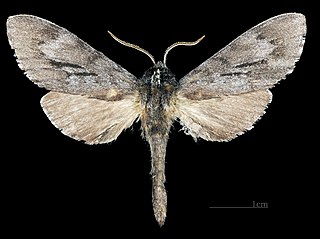
Lapara coniferarum, the southern pine sphinx, is a species of sphinx moth. It was first described by James Edward Smith in 1797. The species is listed as threatened in Connecticut.
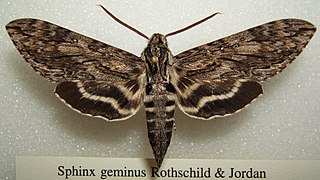
Lintneria geminus, the gemmed sphinx, is a moth of the family Sphingidae. The species was first described by Walter Rothschild and Karl Jordan in 1903. It is found from Mexico to Honduras and Nicaragua with an occasional stray into Texas.

Lintneria istar, the Istar sphinx moth, is a moth of the family Sphingidae. The species was first described by Walter Rothschild and Karl Jordan in 1903. It is found in mountains and pine-oak woodlands from southern Arizona east to southern Texas and south through Mexico to Guatemala.

Sphinx leucophaeata is a moth of the family Sphingidae.

Lintneria separatus, the separated sphinx, is a moth of the family Sphingidae. The species was first described by Berthold Neumoegen in 1885. It is found from Colorado south through New Mexico and Arizona to Veracruz and Hidalgo in Mexico.
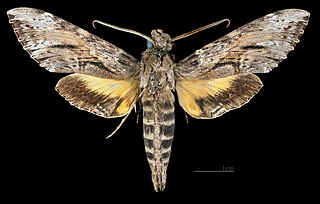
Isognathus rimosa, the rimosus sphinx, is a moth of the family Sphingidae. The species was first described by Augustus Radcliffe Grote in 1865.

Pachylia ficus, known as the fig sphinx, is a moth of the family Sphingidae. It lives from the northern tip of South America in Uruguay through Central America to the southern tip of the United States straying into Arizona and Texas.

Aellopos clavipes, also known as the clavipes sphinx, is a moth of the family Sphingidae.

Enyo lugubris, the mournful sphinx, is a moth of the family Sphingidae. It is found from Argentina and Paraguay to Uruguay, Venezuela, Guyana, Suriname, French Guiana, Colombia, Ecuador, Peru, Brazil and the West Indies through Belize, Guatemala, Honduras, El Salvador, Nicaragua, Costa Rica and Panama to Mexico and the United States, where it has been recorded from Arizona east to Florida and north to South Carolina. Strays have been recorded from Arkansas, north to Illinois, Michigan and New York.

Eumorpha vitis, known as the vine sphinx, is a moth of the family Sphingidae.

Aellopos tantalus, known as the Tantalus sphinx, is a moth of the family Sphingidae. It is found in Florida, the Antilles, from Mexico to Venezuela, Colombia, Ecuador, Suriname, and in the Amazon basin.

Dolbogene is a monotypic moth genus in the family Sphingidae erected by Walter Rothschild and Karl Jordan in 1903. Its only species, Dolbogene hartwegii, or Hartweg's sphinx, was first described by Arthur Gardiner Butler in 1875. It is found from Texas and southern Arizona to Mexico and Guatemala. Only a small number have been caught and not much is known about the biology of this species.
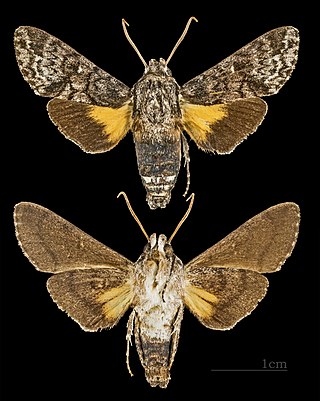
Cautethia is a genus of moths in the family Sphingidae first described by Augustus Radcliffe Grote in 1867.

Cautethia noctuiformis is a species of moth in the family Sphingidae, which is known from the Caribbean. It was described by Francis Walker in 1856.
Cautethia simitia is a species of moth in the family Sphingidae. It was described by Schaus in 1932. It is known from Colombia.

Erinnyis oenotrus, the Oenotrus sphinx, is a moth of the family Sphingidae.
